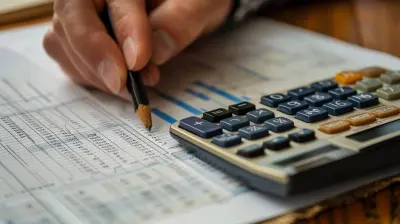How Economic Cycles Affect Your Investment Strategy
27 June 2025
Let’s face it—investing can feel like a wild rollercoaster ride. One moment, you're up, grinning ear to ear as your portfolio climbs sky-high. The next? You're holding on for dear life as things take an unexpected dive. That’s the nature of markets—they move in cycles. And if you’ve ever felt confused or frustrated about why your investments behave the way they do, you’re not alone.
In this post, we’re diving deep into how economic cycles influence your investment strategy. Yep—we're talking booms, busts, and everything in between, breaking it all down in a way that actually makes sense. Whether you're a seasoned investor or just getting started, understanding economic cycles can totally change how you approach investing.
What Are Economic Cycles, Anyway?
First things first. An economic cycle is basically the natural rise and fall of economic growth over time. Think of it like the seasons. There are good times (summer) and not-so-good times (winter), and they often follow one another in a somewhat predictable way. Most economists agree there are four phases:1. Expansion (growth)
2. Peak
3. Contraction (recession)
4. Trough
Each phase affects everything from job availability to consumer spending—and yep, your investments too.
Phase 1: Expansion – Riding the Upward Wave
During the expansion phase, the economy is thriving. People are working, spending money, and businesses are raking in profits. It’s like everyone’s catching a tailwind.What Happens:
- GDP grows steadily- Stock markets generally perform well
- Interest rates are relatively low
- Consumer confidence is high
How to Invest:
This is often the best time to go long on equities (aka stocks). Since companies are making more money, their stock prices usually go up too. Growth stocks, in particular, can really shine here—think tech startups or innovative companies with high potential.Want a tip? Diversify, but don't be afraid to be a bit aggressive. If you're younger and have a higher risk tolerance, this is your season to grow that nest egg.
Phase 2: Peak – The Tipping Point
Eventually, the party has to end—well, sort of. The peak is the point where the economy maxes out before things start to cool down.What Happens:
- Inflation might creep up- Interest rates start to rise
- Stock prices often become overvalued
- Growth slows, but hasn’t stopped yet
How to Invest:
This is where you might want to shift gears a bit. It’s a good time to rebalance your portfolio—maybe lock in some profits from those high-flying stocks.Consider rotating into value stocks or sectors like utilities, consumer staples, and healthcare. These are the "steady Eddies" that tend to hold up better when the going gets tough.
Phase 3: Contraction – Batten Down the Hatches
This phase is the dip—also known as a recession. It’s when things slow down. Businesses cut back, layoffs happen, and people generally spend less.What Happens:
- GDP declines- Unemployment rises
- Stock market drops
- Consumer confidence takes a hit
How to Invest:
This is tough, no doubt about it. But believe it or not, recessions can be one of the best times to spot new opportunities.During downturns, defensive stocks usually outperform. Bonds (especially government bonds) can also offer some much-needed stability.
And if you’re brave, consider it a buyer's market. When stock prices are low, quality companies are basically on sale. It’s risky, but with a long-term view, it can pay off big-time.
Phase 4: Trough – The Calm Before the Rebound
After the worst is over, we hit the bottom—the trough. It’s the turning point before the next expansion kicks in.What Happens:
- Economic indicators begin to stabilize- Central banks may cut interest rates to stimulate growth
- Stock markets start to recover (often before the economy does)
How to Invest:
This is when you start repositioning for growth. Look for leading indicators—stocks or sectors that typically recover early, like tech and consumer discretionary.It’s also a great time to evaluate your risk tolerance and start increasing your equity exposure again if you’d pulled back during the recession. The key is being proactive rather than reactive.
Why Your Investment Strategy Should Change With the Cycle
Imagine riding a bike through changing weather. Do you pedal the same way through a storm as you do on a sunny day? Probably not.Investing works the same way. What works during an expansion could hurt you during a recession. The markets are constantly shifting, and your strategy needs to keep up.
Here’s the thing—timing the market perfectly is almost impossible. But recognizing where we are in the cycle? Now that’s doable. And that knowledge can help you:
- Adjust your risk exposure
- Rebalance your portfolio more effectively
- Avoid panic-selling during downturns
- Take advantage of new investment opportunities
Real-Life Example: The 2008 Financial Crisis
Let’s rewind to 2008. The world was hit with a massive economic contraction. Housing markets crashed. Banks failed. The stock market plummeted.Scary stuff, right?
But guess what? Investors who stayed the course—and maybe even bought undervalued stocks—saw incredible returns over the following decade.
It perfectly highlights how understanding and responding to the economic cycle, rather than reacting emotionally, can make or break your investment outcomes.
How to Spot the Signs of a Cycle Shift
Alright, so how do you know when a shift is coming? While you don’t need a PhD in economics, paying attention to a few key indicators can really help:- GDP Reports – Are we growing or shrinking?
- Interest Rates – What’s the Fed up to?
- Unemployment Rate – Are people losing jobs or getting hired?
- Inflation Data – Is the cost of stuff going up too fast?
- Consumer Confidence Index – Are people optimistic or worried?
These aren’t foolproof, but they’re clues. Combine them with consistent portfolio reviews, and you’ve got a solid strategy.
Tailoring Your Investment Strategy to You
Just like no two people are the same, no two investment strategies should be identical. While the economic cycle gives us the framework, your personal situation fills in the details.Ask yourself:
- How old am I?
- When will I need this money?
- Can I handle risk, or am I more risk-averse?
- What are my long-term goals?
For someone in their 30s saving for retirement, a downturn might be a time to double down. But for someone in their 60s, it could be time to protect what they’ve already built.
Keep a Long-Term Mindset
Let’s be real—economic cycles are normal. They’re not the enemy; they’re part of a healthy economy. Trying to outsmart them every time will wear you out.Instead, focus on building a resilient, diversified portfolio designed to adapt to the ups and downs. Think of it like building a house that can stand through all seasons—spring, summer, fall, and winter.
Patience, consistency, and staying informed—that's your best bet.
Tools to Help You Stay on Track
You don’t have to do all this alone. There are awesome tools and resources to help you adjust your investment strategy as needed:- Investment apps like M1 Finance, Betterment, or Fidelity offer built-in rebalancing tools.
- Financial news outlets like Bloomberg, CNBC, and Morningstar keep you updated on economic shifts.
- Financial advisors can offer personalized advice, especially during transitions between cycles.
Final Thoughts
Economic cycles may seem complicated, but once you break them down, they’re actually pretty intuitive. Just like the seasons change, so does the economy—and your investment strategy should follow suit.By staying aware, being adaptable, and keeping your eye on the long game, you can ride the wave of economic cycles instead of getting wiped out by them. Investing doesn’t have to feel like a guessing game. With a little knowledge and the right mindset, you’ll be in a great position to grow and protect your wealth—no matter what the economy throws your way.
all images in this post were generated using AI tools
Category:
Investment RisksAuthor:

Yasmin McGee
Discussion
rate this article
1 comments
Caitlin Cook
Great insights! Understanding economic cycles is crucial for adapting investment strategies effectively. Thank you for sharing!
July 4, 2025 at 11:39 AM

Yasmin McGee
Thank you for your kind words! I'm glad you found the insights valuable for your investment approach.


